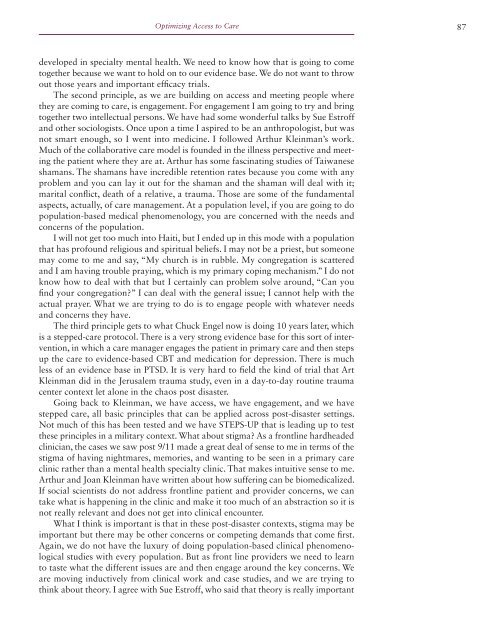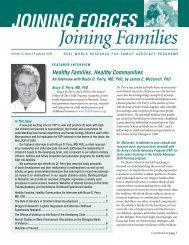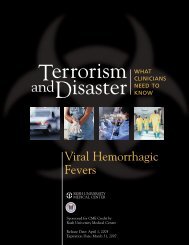stigma and barriers to care - Uniformed Services University of the ...
stigma and barriers to care - Uniformed Services University of the ...
stigma and barriers to care - Uniformed Services University of the ...
You also want an ePaper? Increase the reach of your titles
YUMPU automatically turns print PDFs into web optimized ePapers that Google loves.
Optimizing Access <strong>to</strong> Care 87<br />
developed in specialty mental health. We need <strong>to</strong> know how that is going <strong>to</strong> come<br />
<strong>to</strong>ge<strong>the</strong>r because we want <strong>to</strong> hold on <strong>to</strong> our evidence base. We do not want <strong>to</strong> throw<br />
out those years <strong>and</strong> important efficacy trials.<br />
The second principle, as we are building on access <strong>and</strong> meeting people where<br />
<strong>the</strong>y are coming <strong>to</strong> <strong>care</strong>, is engagement. For engagement I am going <strong>to</strong> try <strong>and</strong> bring<br />
<strong>to</strong>ge<strong>the</strong>r two intellectual persons. We have had some wonderful talks by Sue Estr<strong>of</strong>f<br />
<strong>and</strong> o<strong>the</strong>r sociologists. Once upon a time I aspired <strong>to</strong> be an anthropologist, but was<br />
not smart enough, so I went in<strong>to</strong> medicine. I followed Arthur Kleinman’s work.<br />
Much <strong>of</strong> <strong>the</strong> collaborative <strong>care</strong> model is founded in <strong>the</strong> illness perspective <strong>and</strong> meeting<br />
<strong>the</strong> patient where <strong>the</strong>y are at. Arthur has some fascinating studies <strong>of</strong> Taiwanese<br />
shamans. The shamans have incredible retention rates because you come with any<br />
problem <strong>and</strong> you can lay it out for <strong>the</strong> shaman <strong>and</strong> <strong>the</strong> shaman will deal with it;<br />
marital conflict, death <strong>of</strong> a relative, a trauma. Those are some <strong>of</strong> <strong>the</strong> fundamental<br />
aspects, actually, <strong>of</strong> <strong>care</strong> management. At a population level, if you are going <strong>to</strong> do<br />
population-based medical phenomenology, you are concerned with <strong>the</strong> needs <strong>and</strong><br />
concerns <strong>of</strong> <strong>the</strong> population.<br />
I will not get <strong>to</strong>o much in<strong>to</strong> Haiti, but I ended up in this mode with a population<br />
that has pr<strong>of</strong>ound religious <strong>and</strong> spiritual beliefs. I may not be a priest, but someone<br />
may come <strong>to</strong> me <strong>and</strong> say, “My church is in rubble. My congregation is scattered<br />
<strong>and</strong> I am having trouble praying, which is my primary coping mechanism.” I do not<br />
know how <strong>to</strong> deal with that but I certainly can problem solve around, “Can you<br />
find your congregation” I can deal with <strong>the</strong> general issue; I cannot help with <strong>the</strong><br />
actual prayer. What we are trying <strong>to</strong> do is <strong>to</strong> engage people with whatever needs<br />
<strong>and</strong> concerns <strong>the</strong>y have.<br />
The third principle gets <strong>to</strong> what Chuck Engel now is doing 10 years later, which<br />
is a stepped-<strong>care</strong> pro<strong>to</strong>col. There is a very strong evidence base for this sort <strong>of</strong> intervention,<br />
in which a <strong>care</strong> manager engages <strong>the</strong> patient in primary <strong>care</strong> <strong>and</strong> <strong>the</strong>n steps<br />
up <strong>the</strong> <strong>care</strong> <strong>to</strong> evidence-based CBT <strong>and</strong> medication for depression. There is much<br />
less <strong>of</strong> an evidence base in PTSD. It is very hard <strong>to</strong> field <strong>the</strong> kind <strong>of</strong> trial that Art<br />
Kleinman did in <strong>the</strong> Jerusalem trauma study, even in a day-<strong>to</strong>-day routine trauma<br />
center context let alone in <strong>the</strong> chaos post disaster.<br />
Going back <strong>to</strong> Kleinman, we have access, we have engagement, <strong>and</strong> we have<br />
stepped <strong>care</strong>, all basic principles that can be applied across post-disaster settings.<br />
Not much <strong>of</strong> this has been tested <strong>and</strong> we have STEPS-UP that is leading up <strong>to</strong> test<br />
<strong>the</strong>se principles in a military context. What about <strong>stigma</strong> As a frontline hardheaded<br />
clinician, <strong>the</strong> cases we saw post 9/11 made a great deal <strong>of</strong> sense <strong>to</strong> me in terms <strong>of</strong> <strong>the</strong><br />
<strong>stigma</strong> <strong>of</strong> having nightmares, memories, <strong>and</strong> wanting <strong>to</strong> be seen in a primary <strong>care</strong><br />
clinic ra<strong>the</strong>r than a mental health specialty clinic. That makes intuitive sense <strong>to</strong> me.<br />
Arthur <strong>and</strong> Joan Kleinman have written about how suffering can be biomedicalized.<br />
If social scientists do not address frontline patient <strong>and</strong> provider concerns, we can<br />
take what is happening in <strong>the</strong> clinic <strong>and</strong> make it <strong>to</strong>o much <strong>of</strong> an abstraction so it is<br />
not really relevant <strong>and</strong> does not get in<strong>to</strong> clinical encounter.<br />
What I think is important is that in <strong>the</strong>se post-disaster contexts, <strong>stigma</strong> may be<br />
important but <strong>the</strong>re may be o<strong>the</strong>r concerns or competing dem<strong>and</strong>s that come first.<br />
Again, we do not have <strong>the</strong> luxury <strong>of</strong> doing population-based clinical phenomenological<br />
studies with every population. But as front line providers we need <strong>to</strong> learn<br />
<strong>to</strong> taste what <strong>the</strong> different issues are <strong>and</strong> <strong>the</strong>n engage around <strong>the</strong> key concerns. We<br />
are moving inductively from clinical work <strong>and</strong> case studies, <strong>and</strong> we are trying <strong>to</strong><br />
think about <strong>the</strong>ory. I agree with Sue Estr<strong>of</strong>f, who said that <strong>the</strong>ory is really important




